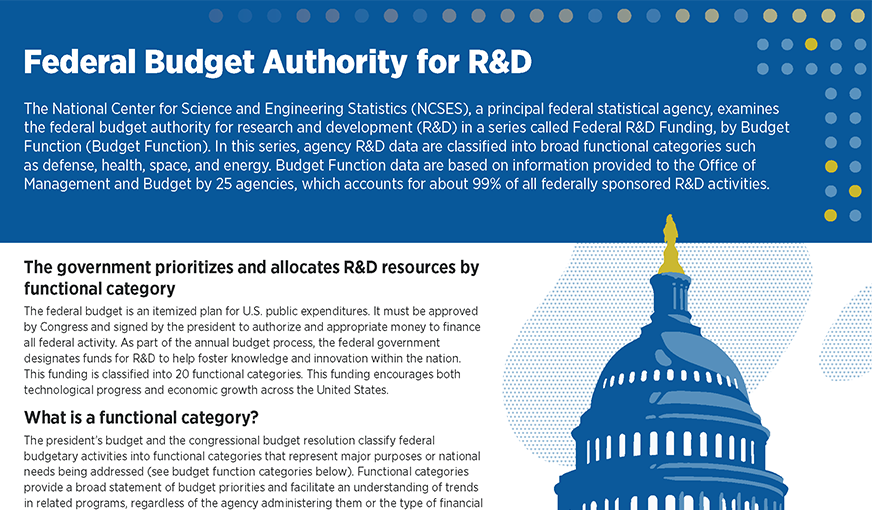In this report, R&D refers to basic research, applied research, and experimental development activities in science and engineering.
Research and experimental development is creative and systematic work undertaken in order to increase the stock of knowledge—including knowledge of people, culture, and society—and to devise new applications using available knowledge.
R&D includes administrative expenses, such as the operating costs of research facilities and equipment and other overhead costs. It also includes funds for the purchase of minor equipment—such as personal computers, standard microscopes, and simple spectrometers.
Basic research is experimental or theoretical work undertaken primarily to acquire new knowledge of the underlying foundations of phenomena and observable facts. Basic research may include activities with broad or general applications in mind, such as the study of how plant genomes change, but should exclude research directed toward a specific application or requirement, such as the optimization of the genome of a specific crop species.
Applied research is original investigation undertaken in order to acquire new knowledge. Applied research is, however, directed primarily toward a specific, practical aim or objective.
Experimental development is creative and systematic work, drawing on knowledge gained from research and practical experience, which is directed at producing new products or processes or improving existing products or processes. Like research, experimental development will result in gaining additional knowledge.
Experimental development activities include (1) the production of materials, devices, and systems or methods, including the design, construction, and testing of experimental prototypes and (2) technology demonstrations, where a system or component is being demonstrated at scale for the first time and it is realistic to expect additional refinements to the design (feedback R&D) following the demonstration.
Before the publication of OMB’s revised guidance in Circular A-11 of July 2016, a more expansive definition of “development” was the basis for agency R&D reporting. The present guidance now identifies several specific exclusions. Experimental development does not include (1) user demonstrations, where the cost and benefits of a system are being validated for a specific use case (e.g., low-rate initial production activities), or (2) preproduction development, which is defined as nonexperimental work on a product or system before it goes into full production, including activities such as tooling and development of production facilities. For example, activities and programs that are categorized as “Operational Systems Development” in the Department of Defense’s research, development, test, and evaluation (RDT&E) budget activity structure are no longer included as R&D. Activities and programs of that type generally are now reported as investments in other major non-R&D equipment.
R&D plant includes facilities and major equipment necessary for the execution of an R&D program. It includes the purchase, construction, manufacture, rehabilitation, or major improvement of physical assets such as land, major fixed equipment, and supporting infrastructure like a sewer line or housing at a remote location. It also includes the acquisition, design, or production of major movable equipment, such as mass spectrometers, research vessels, DNA sequencers, and other movable major instruments for use in R&D activities.
The data in this report exclude (1) all non-R&D activities performed within budget functions that conduct R&D and (2) all functions in which no R&D is conducted. Table 6 is an exception, however; it continues to report RDT&E totals that previously would have been classified as R&D. In part, this table provides a gauge of the impact of the narrowed definition of development (as detailed earlier) on defense R&D totals.
 An official website of the United States government
An official website of the United States government



